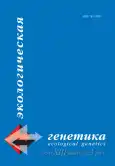Obtaining of interspecific hybrids for pea introgressive breeding
- Authors: Bobkov S.V.1, Selikhova T.N.1
-
Affiliations:
- All-Russia Research Institute of Legumes and Groat Crops, Doctor of agriculture, senior scientist
- Issue: Vol 13, No 3 (2015)
- Pages: 40-49
- Section: Articles
- URL: https://journals.rcsi.science/ecolgenet/article/view/2410
- DOI: https://doi.org/10.17816/ecogen13340-49
- ID: 2410
Cite item
Full Text
Abstract
Full Text
##article.viewOnOriginalSite##About the authors
Sergey Vasilevich Bobkov
All-Russia Research Institute of Legumes and Groat Crops, Doctor of agriculture, senior scientist
Email: svbobkov@gmail.com
head of plant physiology and biochemistry laboratory
Tatyana Nikolaevna Selikhova
All-Russia Research Institute of Legumes and Groat Crops, Doctor of agriculture, senior scientist
Email: tat.selihowa@yandex.ru
Doctor of biology, senior scientist of plant physiology and biochemistry laboratory
References
- Бобков С. В., Лазарева Т. Н. (2012) Компонентный состав электрофоретических спектров запасных белков межвидовых гибридов гороха. Генетика. Т. 48 (1): С. 56-61.
- Бобков С. В., Уварова О. В. (2010) Растительный белок зернобобовых культур и перспектива получения белковых изолятов. Вестник РАСХН. № 6: С. 83-88.
- Богданова В. С., Галиева Э. Р. (2009) Нарушения мейоза как проявление ядерно-цитоплазматической несовместимости при скрещивании подвидов посевного гороха. Генетика. Т. 45 (5): С. 711-716.
- Доспехов Б. А. (1985) Методика полевого опыта (с основами статистической обработки результатов исследований). М.: Агропромиздат.
- Конарев В. Г. (2000) Идентификация сортов и регистрация генофонда культурных растений по белкам семян. СПб.: ВИР.
- Ali S. M., Sharma B., Ambrose M. J. (1994) Current status and future strategy in breeding pea to improve resistance to biotic and abiotic stresses. Euphytica. V. 73: P. 115-126.
- Baranger A. G., Aubert G., Arnau G. et al. (2004) Genetic diversity within Pisum sativum using protein - and PCR based markers. Theorethical and Applied Genetics. V. 108: P. 1309-1321.
- Baranyi M., Greilhuber J., Swiecicki W. K. (1996) Genome size in wild Pisum species. Theoretical and Applied Genetics. V. 93: P. 717-721.
- Ben-Ze’ev N., Zohary D. (1973) Species relationship in the genus Pisum L. Israel Journal of Botany. V. 22: P. 73-91.
- Bobkov S. (2014) Obtaining calli and regenerated plants in anther cultures of pea. Czech Journal of Genetics and Plant Breeding. V. 50 (2): P. 123-129.
- Bogdanova V. S., Kosterin O. E. (2007) Hybridization barrier between Pisum fulvum Sibth. et Smith and P. sativum L. is partly due to nuclear-chloroplast incompatibility. Pisum Genetics. V. 39: P. 8-9.
- Byrne O. M., Hardie D. C., Khan T. N. et al. (2008) Genetic analysis of pod and seed resistance to pea weevil in a Pisum sativum × P. fulvum interspecific cross. Australian Journal of Agricultural Research. V. 59: P. 854-862.
- Casey R., Domoney C., Nielsen N. C. (1985) Isolation of a cDNA clone for pea (Pisum sativum) seed lipoxygenase. Biochem. J. V. 232: P. 79-85.
- Clarke H. J., Wilson J. G., Kuo I., Lulsdorf M. M., Mallikarjuna N., Kuo J., Siddique K. H. M. (2006) Embryo rescue and plant regeneration in vitro of selfed chickpea (Cicer arietinum L.) and its wild annual relatives. Plant Cell, Tissue and Organ Culture. 85: 197-204.
- Clement S. L., McPhee K. E., Elberson L. R., Evans M. A. (2009) Pea weevil, Bruchus pisorum L. (Coleoptera: Bruchidae), resistance in Pisum sativum × Pisum fulvum interspecific crosses. Plant Breeding. V. 128: 478-485.
- Domoney C., Firmin J. L., Sidebottom C. et al. (1990) Lipoxygenase heterogeneity in Pisum sativum. Planta. V. 181: P. 35-43.
- Ellis T. H. N. (2011) Pisum. In: C. Kole (ed.). Wild crop relatives: genomic and breeding resources, legume crops and forages. Berlin Heidelberg: Springer-Verlag; p. 237-248.
- Fondevilla S., Cubero J. I., Rubiales D. (2010) Confirmation that the Er3 gene, conferring resistance to Erysiphe pisi in pea, is a different gene from er1 and er2 genes. Plant Breeding. V. 130 (2): P. 281-282.
- Kosterin O.E, Bogdanova V. S. (2014) Efficient of hand pollination in different pea (Pisum) species and subspecies. Indian J. Genet. V. 74 (1): P. 50-55.
- Ochatt S. J., Benabdelmouna A., Marget P. et al. (2004) Overcoming hybridization barriers between pea and some of its wild relatives. Euphytica. V. 137: P. 353-359.
- Porta H., Rocha-Sosa M. (2002) Plant lipoxygenases. Physiological and molecular features. Plant Physiology. V. 130: P. 15-21.
- Shand P. J., Ya H., Pietrasik Z., Wanasundara P. K. J.P. D. (2007) Physicochemical and textural properties of heat-induced pea protein isolate gels. Food Chemistry. V. 102: P. 1119-1130.
- Smykal P., Kenicer G., Flavell A. J. et al. (2011) Phylogeny, phylogeography and genetic diversity of the Pisum genus. Plant Genetic Resources: Characterization and Utilization. V. 9 (1): P. 4-18.
- Su C., Oliw E. H. (1998) Manganese lipoxygenase: characterization and purification. J. Biol. Chem. V. 273: P. 13072-13079.
- Suvorova G. (2014) Hybridization of cultivated lentil Lens culinaris Medik. and wild species Lens tomentosus Ladizinsky. Czech Journal of Genetics and Plant Breeding. V. 50: 130-134.
- Zaytseva O. O., Bogdanova V. S., Kosterin O. E. (2012) Phylogenetic reconstruction at the species and intraspecies levels in the genus Pisum (L.) (peas) using a histone H1 gene. Gene. V. 504: P. 192-202.
Supplementary files






